March 4, 1864: “The Saint of the Pacific Coast” Lays Down His Burdens
That’s what contemporaries call Universalist and Unitarian minister Thomas Starr King, who lies on his San Francisco deathbed, 160 years ago. According to Charles Wendte’s 1921 biography of Starr King, the resonant orator — whose passionate sermons are instrumental in keeping California in the Union during the Civil War — tells his wife, Julia:
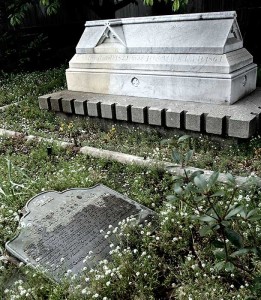
Starr King’s Tomb
“Don’t weep for me. I know it’s all right. I wish I could make you feel so; I wish I could describe my feelings. It’s strange. I see all the privileges and greatness of the future. It already looks grand, beautiful. Tell them at home I went lovingly, trustfully, peacefully.”
-
Although his slight build and boyish features make him appear half his age, Starr King dies nine months before his 40th birthday.
Flags throughout San Francisco fall to half-mast. Lawmakers in Sacramento pass a resolution declaring Starr King a “tower of strength to the cause of his country” and declare three days of mourning. Draped in an American flag, King lies in state in the newly constructed San Francisco Unitarian Church at 133 Geary Street, surrounded by a military honor guard. An estimated 20,000 people pay their respects. San Francisco waives its ban on burials to allow Starr King’s sarcophagus to be placed on the church’s front lawn. It’s now located at the Unitarian church at 1187 Franklin Street built in 1889.
Author Bret Harte writes “Relieving Guard,” a eulogy for his friend.
Starr King’s fame precedes him in California. It’s built on this 11 years as minister of Boston’s Hollis Street Unitarian Church and as a popular lecturer who draws bigger and bigger crowds to hear him expound on Socrates, “Substance and Show,” “Existence and Life,” “The Laws of Disorder” and other topics.
Because of his preeminence in the East, when Starr King visits Yosemite shortly after arriving in California in 1860 and writes letters describing the valley’s grandeur, they’re published in the Boston Evening Transcript. After his death, Starr King’s Yosemite writings are collected in a book. An excerpt:
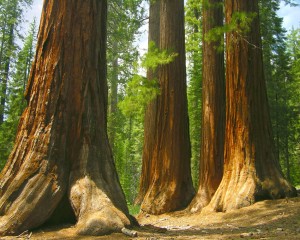
Mariposa Grove’s Giant Sequoias
“The patches of luxuriant meadow with their dazzling green and the grouping of the superb firs, 200 feet high, that skirt them and that shoot above the stout and graceful oaks and sycamores, through which the horse path winds, are delightful rests of sweetness and beauty amid the threatening awfulness — like the threads and flashes of melody that relieve the towering masses of Beethoven’s harmony. The Ninth Symphony is the Yo-Semite of music….
“The immense escarpment (El Capitan) has no crack or mark of stratification. There is no vegetation growing anywhere on it, for there is no patch of soil on either front and no break where soil can lodge and a plant can grow. It is one block of naked granite, pushed up from below to give us a sample of the cellar-pavement of our California counties and to show us what it is that our earthquakes joggle. But on one face the wall is weather stained or lichen-stained with rich cream-colored patches; on the other face it is ashy grey. A more majestic object than this rock? I expect never to see on this planet. Great is granite, and the Yo-Semite is its prophet!”
Starr King’s descriptions of the valley’s majesty contribute to the 1863 passage of legislation by California Senator John Conness, signed by President Abraham Lincoln, that protects Yosemite from development, the first time the federal government sets land aside for preservation.
In its March 5, 1864 obituary of Starr King, the Alta California writes: “Such was his fame and influence that these letters had a wide audience in the East with a substantial effect upon Yosemite’s destiny.”
Starr King is one of the first 100 white men to visit Lake Tahoe, then named Lake Bigler after former Democratic Gov. John Bigler. An 1863 sermon is titled “Living Water from Lake Tahoe.” One of his most famous naturalism sermons is “Lessons from the Sierra Nevada” contains some of his best known naturalist writings. An excerpt from Starr King’s Tahoe sermon:
-
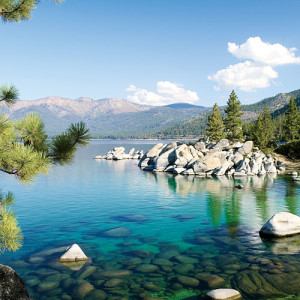
Lake Tahoe
“I must speak of another lesson, connected with religion, that was suggested to me on the borders of Lake Tahoe. It is bordered by groves of noble pines. Two of the days which I was permitted to enjoy there were Sundays. On one of them I passed several hours of the afternoon in listening, alone, to the murmur of the pines, while the waves were gently beating the shore with their restlessness. If the beauty and purity of the lake were in harmony with the deepest religion of the Bible, certainly the voice of the pines was also in chord with it. What grandeur, what tenderness, what pathos, what heart-searchingness in the swells and cadences of its ‘Andante Maestoso,’ when the wind wrestles with it and brings out all its soul.”
In Lessons from the Sierra Nevada:
“We are not to live outside the world, but in it, feeling its passions, working in its interests, striving to do our duty in its trials. And yet large districts of our life and feeling should be above the world, on the Sierra heights from which the world and our toil and our home cares and our surroundings look noble, precious, bathed in light….”
California’s “Patriot-Preacher”
When Starr King arrives in California in April 1860, secession fever is high. Of the state’s 53 newspapers, seven support Lincoln.
California’s U.S. Sen. William Gwin is an unscrupulous Tennessee native. California Chief Justice David Terry is a hot-tempered Texan. Gov. John Weller is a Lecompton – Pro-Southern—Democrat. So is his successor, Milton Latham, appointed to fill the Senate seat left vacant by the death of San Francisco’s David Broderick, killed by Terry in a duel.
In California’s political leadership, all are Democrats, a majority has strong Southern leanings and the lone voice railing against slavery – Broderick – is silenced. Southern California leans pro-slavery and is squarely anti-Northern California. Weller signs legislation allowing the southern part of the state to break off and become the Territory of Colorado, which the idea’s supporters say will be allow slavery. Writes William Day Simonds in his 1907 Starr King in California: “California’s destiny in this critical hour was chiefly determined by the word and work of her patriot-preacher, Starr King.”
Starr King who has an audience of 1,000 or more for his Sunday morning sermons and slightly less in the evening, considers slavery an abomination. The Union — a united America – is sacrosanct. “What a privilege it is to be an American,” he often says. There is no separation of church and state in his sermons or his oratory:
“The Rebellion—it is the cause of Wrong against Right. It is not only an unjustifiable revolution but a geographical wrong, a moral wrong, a religious wrong, a war against the Constitution, against the New Testament, against God.”
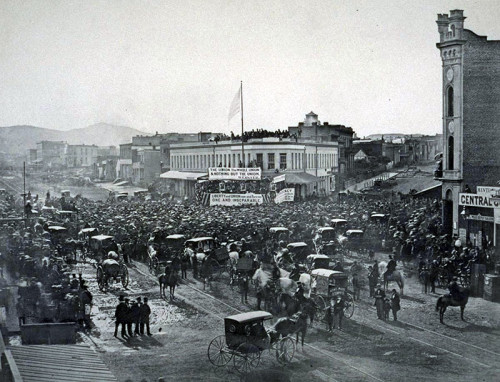
An 1861/1862 Crowd Listens to Starr King
Besieged with speaking invitations, Starr King accepts them all, whether major cities or mining camps. He barnstorms California, speaking from a podium draped with an American flag, defending the Union and supporting Abraham Lincoln. At one mass rally in san Francisco, 40,000 gather to hear him speak. HIs friend, His friend, Edward Everett Hale, author of “The Man Without a Country,” says “Starr King was an orator no one could silence and no one could answer.”
Starr King calls for an “emancipation proclamation” nearly two years before Lincoln issues one:
“O’ that the President would soon speak that electric sentence —inspiration to the loyal North, doom to the traitorous aristocracy whose cup of guilt is full! Let him say that it is a war of mass against class, of America against feudalism, of the schoolmaster against the slave-master, of workmen against the barons, of the ballot box against the barracoon. This is what the struggle means. Proclaim it so, and what a light breaks through our leaden sky! The war-wave rolls then with the impetus and weight of an idea.”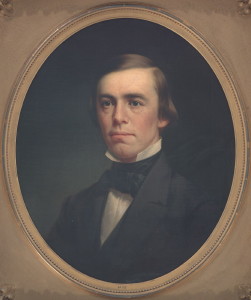
Lincoln ekes out a win in California with 32.3 percent of the vote – just 724 votes more than the 37,999 cast for the closest of his three opponents, Illinois Sen. Stephen Douglas. But the secessionist spirit doesn’t abate. On July 4, 1861, a Confederate flag waves over Los Angeles. Gen. E.V. Sumner, named commander of U.S. troops on the Pacific Coast in March 1861, tells Lincoln’s War Department: “The disaffection in the southern part of the state is increasing and is becoming dangerous and it is indispensably necessary to throw reinforcements into that section immediately.”
Starr King continues his speeches and sermons, in praise of patriotism and the Union and his parishioner, Leland Stanford, who is elected California first Republican governor September 4, 1861. Humor is major part of Starr King’s oral arsenal. Edwin P. Whipple, one of Starr King’s earliest biographers and author of the introduction to the 1877 collection, Substance and Show and Other Lectures By Thoms Starr King describes the preacher as “gifted with an exquisite, a delicious sense of the ludicrous, and given to bursts of uncontrollable merriment, happy as childhood and as innocent.”
Towards the end of his life, Starr King says, “Though I weigh only 120 pounds, when I’m mad, I weigh a ton.” Told he is being mentioned as a candidate for the U.S. Senate, Starr King replies: “I would swim to Australia before taking a political post. A dandy lives from one necktie to another, a fashionable woman from one wrinkle to another and a politician from one election to another.”
___________________________
“I PLEDGED CALIFORNIA TO A NORTHERN REPUBLIC AND TO A FLAG THAT SHOULD HAVE NO TREACHEROUS THREADS OF COTTON IN ITS WARP, AND THE AUDIENCE CAME DOWN IN THUNDER.”
___________________________
Sarcasm also plays a role:
“There are those who say that they are Union men, and in favor of the Government, and yet they are bitterly opposed to the administration, and cannot support its policy. But in a war for self existence, this divorce is impossible. One might as well say at a fire, while his house is beginning to crackle in the flames, ‘I am in favor of this engine, I go for this water; the hose meets my endorsement. Certainly, I am for putting out the fire, but don’t ask me to help man the brakes, for I am conscientiously opposed to the hose pipe. Its nozzle isn’t handsome. It wasn’t made by a Democrat.'”
Satisfied that a Republican governor will hold any secessionist efforts in check, Starr King turns his energies to improving the appalling care of wounded soldiers, who often lacked sheets and blankets. Medical staff was small and usually poorly trained. Hospitals are unsanitary and inadequate. Rev. H.W. Bellows of New York creates the U.S. Sanitary Commission, a forerunner of the American Red Cross, in 1861. Starr King is the Sanitary Commission in California. To aid Union soldiers, the commission raises $4.8 million nationwide. Of that, Starr King convinces California to give $1.25 million, $200,000 from San Francisco.
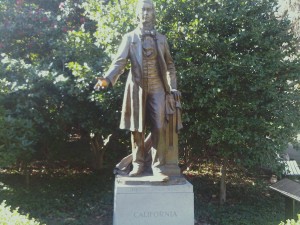
Starr King’s Statue in CapitoL Park
Simonds notes that this generosity comes despite an 1862 flood in the Sacramento and San Joaquin valleys that destroys $50 million in property and a drought the following year that wipes out the state wheat crop. On the day of his death, the San Francisco Bulletin writes:
“The announcement of the death of Rev. Thomas Starr King startles the community, and shocks it like the loss of a great battle or tidings of a sudden and undreamed of public calamity. Certainly no other man on the Pacific Coast would be missed so much. San Francisco has lost one of her chief attractions; the State, its noblest orator; the country one of her ablest defenders.”
One of the sequoias in the Mariposa Grove is named Starr King, as is a 9,096-foot granite dome in Yosemite.
In 1913, Starr King is judged one of California’s two greatest heroes. Money is raised to cast a bronze statute of him that will stand in the National Statuary Hall Collection of the U.S. Capitol. It takes awhile: Starr King’s statue is donated to the hall in 1931.
Seventy-five years later, the state Legislature approves — with only one dissenting vote — Senate Joint Resolution 3 to bounce Starr King’s statue from the National Statuary Hall and replace it with one of Ronald Reagan.
The resolution is authored by Sen. Dennis Hollingsworth, a Murieta Republican, who admits to the San Francisco Chronicle that he doesn’t know who Starr King is, adding “I think there’s probably a lot of Californians like me.”
Hollingsworth tells the Chronicle that Starr King also wasn’t born in California although that criteria isn’t applied to Reagan, born in Illinois, or the other statue California has in the national hall — Father Junipero Serra, born in Majorca Spain. The only “no” vote on the resolution comes from then Sen. Debra Bowen, later California’s Secretary of State from 2006 to 2014, who apparently is aware of Starr King’s contributions to the state.
In November 2009, Starr King’s statute is placed in Civil War Memorial Grove in Sacramento’s Capitol Park.
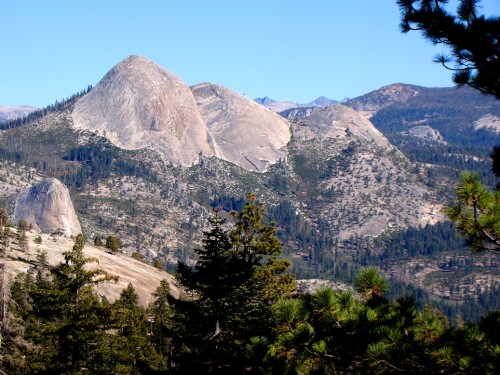
Yosemite’s Mt. Starr King
Filed under: California History
- Capitol Cliches (16)
- Conversational Currency (3)
- Great Moments in Capitol History (4)
- News (1,288)
- Budget and Economy (383)
- California History (139)
- Demographics (11)
- Fundraising (74)
- Governor (122)
- Legislature/Legislation (270)
- Politics (173)
- State Agencies (38)
- Opinionation (36)
- Overheard (246)
- Today's Latin Lesson (45)
- Restaurant Raconteur (21)
- Spotlight (110)
- Trip to Tokyo (8)
- Venting (184)
- Warren Buffett (43)
- Welcome (1)
- Words That Aren't Heard in Committee Enough (11)

As an active Unitarian, I truly enjoyed this bit of history. Even I didn’t know all of this. Thanks for running it.
Comment by JoAnn Anglin — 3.04.2014 @ 9:43 pm
I am glad to read this article. The photograph of the crowd of people listening to Starr King is one I have never seen. I was ordained by and served the San Francisco congregation where he had such an impact, preaching in the Starr King pulpit and looking out at his sarcophagus each day. The marble baptismal font was a gift from the New York City congregation of Henry Whitney Bellows and has carved heads of Bellows and King in its ornate design. The large meeting halls are named for the Reverends Thomas Starr King and Martin Luther King, Jr. The church is located at Franklin & Geary & Starr King Way. It is a beautiful, historic structure that survived the 1906 earthquake with its redwood ceiling, stone walls, and rose windows.
The Unitarian Universalist theological school in Berkeley is also named for King: Thomas Starr King School for the Ministry.
His spirit of engagement with issues of the day, lively humor, and passion for justice continue today.
Rev. Diane Miller, Carlisle MA
Comment by Rev. Diane Miller — 3.05.2014 @ 3:47 am
Great piece about a truly great man. He left a magnificent legacy for one so young. His story should be mandatory in our schools . Dennis Hollingsworth’s ignorance of him probably would have angered Ronald Reagan.
Comment by Bill Schreiber — 3.05.2014 @ 8:23 am
Very interesting. Was very familiar with the name (attended Starr King Elementary School in Long Beach) but never knew the history. Thanks!
Comment by Chazz Ferrazzi — 3.05.2014 @ 10:20 am